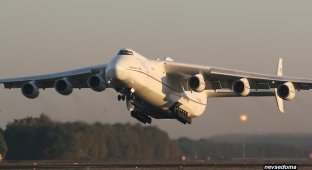How the An-225 Mriya works - the largest aircraft in the world (78 photos)
The An-225 Mriya is the heaviest cargo-lifting aircraft ever taken into the air. The maximum take-off weight of the aircraft is 640 tons. The reason for the construction of the An-225 was the need to create an aviation transport system for the Soviet reusable spacecraft Buran project. The plane exists in a single copy.

The aircraft was designed in the USSR and built in 1988 at the Kiev Mechanical Plant.
"Mriya" set a world record for take-off weight and carrying capacity. On March 22, 1989, the An-225 flew with a load of 156.3 tons, thereby simultaneously breaking 110 world aviation records, which is a record in itself.

Since the start of operation, the aircraft has flown 3,740 hours. If we assume that the average flight speed (taking into account take-off, climb, cruising, descent, approach) is about 500 km/h, then we can calculate the approximate value of the kilometers traveled: 500 x 3740 = 1,870,000 km (more than 46 revolutions around the Earth along the equator).

The scale of the An-225 is amazing: the length of the aircraft is 84 meters, the height is 18 meters (like a 6-story 4-entrance house)

A visual comparison of the Mriya and the passenger Boeing 747.
If we take the largest of the Boeing 747-800 as a basis, then the length of the An-225 will be 8 meters longer, and the wingspan will be 20 meters longer.
Compared to the Airbus A380, the Mriya is 11 meters longer, and its wingspan is almost 9 meters longer.

It happens that the airport does not have adequate parking for such a large aircraft, and it is parked directly on the runway.
Of course, we are talking about an alternate runway, if the airport has one.

The wingspan is 88.4 meters and the area is 905 m?
The only aircraft superior to the An-225 in terms of wingspan is the Hughes H-4 Hercules, which belongs to the class of flying boats. The ship took off only once, in 1947. The history of this aircraft was reflected in the film "The Aviator"

Since the Buran spacecraft itself and the blocks of the Energia launch vehicle had dimensions exceeding the dimensions of the Mriya’s cargo compartment, the new aircraft provided for securing cargo from the outside. In addition, it was planned that the aircraft would be used as the first stage for the launch of a spacecraft.

The formation of a wake from a large cargo attached to the top of the aircraft required the installation of a double-finned tail unit to avoid aerodynamic shading.

The aircraft is equipped with 6 D-18T engines.
At takeoff mode, each engine develops a thrust of 23.4 tons (or 230 kN), i.e., the total thrust of all 6 engines is 140.5 tons (1380 kN).

It can be assumed that each engine develops about 12,500 horsepower at takeoff!

The D-18T engines of the An-225 aircraft are the same as those on the An-124 Ruslan.
The height of such an engine is 3 m, width 2.8 m, and weight more than 4 tons.

The starting system is air, with electrical automatic control. The auxiliary power unit, consisting of two TA-12 turbo units installed in the left and right fairings of the chassis, provides autonomous power to all systems and engine starting.

The mass of fuel in the tanks is 365 tons, it is placed in 13 wing caisson tanks.
The aircraft can remain in the air for 18 hours and cover a distance of over 15,000 km.

The refueling time for such a vehicle ranges from half an hour to a day and a half, and the number of tankers depends on their capacity (from 5 to 50 tons), i.e. from 7 to 70 tankers.

The aircraft's fuel consumption is 15.9 tons/h (in cruising mode)
When fully loaded, the aircraft can remain in the sky without refueling for no more than 2 hours.

The chassis includes a two-post nose and 14-post main (7 posts on each side) supports.
Each stand has two wheels. Total 32 wheels.

Wheels require replacement every 90 landings.
Tires for Mriya are produced at the Yaroslavl Tire Plant. The price of one tire is about $1000.

On the bow strut there are wheels measuring 1120 x 450 mm, and on the main strut there are wheels measuring 1270 x 510 mm.
The pressure inside is 12 atmospheres.

Since 2001, the An-225 has been performing commercial cargo transportation as part of Antonov Airlines.

Dimensions of the cargo compartment: length - 43 m, width - 6.4 m, height - 4.4 m.
The cargo cabin of the aircraft is sealed, which allows the transportation of various types of cargo. Inside the cabin you can place 16 standard containers, up to 80 cars and even heavy-duty BelAZ dump trucks. There is enough space here to fit the entire body of a Boeing 737.

Access to the cargo compartment is through the nose of the aircraft, which folds up.

The process of opening/closing the cargo compartment ramp takes no more than 10 minutes.

To unfold the ramp, the aircraft performs the so-called “elephant bow.”
The nose landing gear tilts forward, and the weight of the aircraft is transferred to auxiliary supports, which are installed under the front threshold of the cargo compartment.

Auxiliary support.

Control panel for the aircraft's "squat" system.

This loading method has a number of advantages compared to the Boeing 747 (which is loaded through a compartment in the side of the fuselage.

"Mriya" is a record holder for the weight of cargo transported: commercial - 247 tons (which is four times more than the maximum payload of a Boeing 747), commercial monocargo - 187.6 tons, and an absolute record for carrying capacity - 253.8 tons. On June 10, 2010, the longest cargo in the history of air transportation was transported - two windmill blades, each 42.1 m long.

To ensure a safe flight, the center of gravity of an aircraft with cargo must be within certain limits along its length. The load master performs loading in strict accordance with the instructions, after which the co-pilot checks the correct placement of the cargo and reports this to the crew commander, who makes a decision on the possibility of carrying out the flight and is responsible for this.

The aircraft is equipped with an on-board loading complex consisting of four lifting mechanisms, each with a lifting capacity of 5 tons.
In addition, two floor winches are provided for loading non-self-propelled wheeled vehicles and cargo on the loading ramp.

This time, the An-225 was chartered by the French engineering company Alstom to transport 170 tons of cargo from Zurich, Switzerland to Bahrain with refueling in Athens and Cairo.

This is a turbine rotor, a turbogenerator for producing electricity and components.

Flight manager Vadim Nikolaevich Deniskov.

To tow the An-225 aircraft, it is impossible to use the carrier of aircraft from other companies, so the carrier is transported on board the aircraft.
And since the aircraft is not equipped with a rear cargo hatch and the towing carrier is unloaded and loaded through the front cargo hatch, which requires a full cycle of squatting of the aircraft onto the front support, as a result, at least 30 minutes are lost and the resource of the aircraft structure and squatting system is unjustifiably consumed.

Technician-foreman for aircraft maintenance.

To ensure turns when the aircraft moves on the ground, the last four rows of the main support struts are made orientable.

Aircraft maintenance technician: specialization: hydraulic system and landing gear.

The heavy weight of the aircraft causes the landing gear to leave marks on the asphalt.

Ladder and hatch to the cockpit.

The passenger compartment is divided into 2 parts: in the front there is the aircraft crew, and in the rear there are accompanying and maintenance personnel.
The cabins are sealed separately - they are separated by a wing.

The rear part of the accompanying cabin is intended for eating, working with technical documentation and holding conferences.
The aircraft has 18 seats for rest of crew members and members of the engineering and technical team - 6 seats in the front cabin and 12 in the rear.

Staircase and hatch to the attendant cabin at the rear of the aircraft.

Technical compartment located at the rear of the cockpit.
On the shelves you can see the blocks that ensure the operation of various aircraft systems, and the pipelines of the pressurization and air conditioning system and the anti-icing system. All aircraft systems are highly automated and require minimal crew intervention during operation. Their work is supported by 34 on-board computers.

Wall of the front center section spar. It is installed (from top to bottom): the slats transmission and air bleed pipelines from the engines.
In front of it are stationary cylinders of the fire protection system with the fire extinguishing agent "Freon".

Stickers are souvenirs from numerous visitors on the panel on the plane's emergency escape hatch flap.

The farthest point from the base airport that the plane managed to visit was the island of Tahiti, part of French Polynesia.
The distance along the shortest arc of the globe is about 16,400 km.

Rynda An-225
Vladimir Vladimirovich Mason mentioned in the engraving is an aircraft operation engineer who worked at Mriya for many years.


The aircraft commander (PIC) is Vladimir Yurievich Mosin.
To become an An-225 commander, you must have at least 5 years of experience flying an An-124 aircraft as a commander.

Weight and alignment control is simplified by installing a load-measuring system on the chassis.

The aircraft crew consists of 6 people:
aircraft commander, co-pilot, navigator, senior flight engineer, aviation equipment flight engineer, flight radio operator.

ORES
To reduce efforts on the throttles and increase the accuracy of setting engine operating modes, a remote engine control system is provided. In this case, the pilot makes a relatively small effort to use cables to move the lever of an electromechanical device mounted on the engine, which reproduces this movement on the fuel regulator lever with the necessary force and accuracy. For the convenience of joint control during takeoff and landing, the throttle levers of the outermost engines (RUD1 and RUD6) are linked, respectively, with RUD2 and RUD5.

The helm of the largest aircraft in the world.
Aircraft control is booster i.e. The control surfaces are deflected solely with the help of hydraulic steering actuators, if they fail, it is impossible to control the aircraft manually (with an increase in the required effort). Therefore, quadruple redundancy was applied. The mechanical part of the control system (from the steering wheel and pedals to hydraulic steering actuators) consists of rigid rods and cables.
The total length of these cables is: the aileron control system in the fuselage - about 30 meters, in each console (left, right) of the wing - approximately 35 meters; elevator and rudder control systems - about 65 meters each.

When the plane is empty, 2400 m of runway is enough for takeoff and landing.
Takeoff with maximum weight - 3500 m, landing with maximum weight - 3300 m.

At the executive start, the engines begin to warm up, which takes about 10 minutes.
This prevents engine surge during takeoff and ensures maximum takeoff thrust. Of course, this requirement leads to the fact that: takeoff is carried out during a period of minimal airport congestion, or the plane waits a long time for its turn to take off, missing scheduled flights.

The takeoff and landing speed depends on the takeoff and landing weight of the aircraft and ranges from 240 km/h to 280 km/h.

The climb is carried out at a speed of 560 km/h, with a vertical speed of 8 m/s.

At an altitude of 7100 meters, the speed increases to 675 km/h with further continuation of the climb to the flight level.

Cruising speed of An-225 - 850 km/h
When calculating cruising speed, the weight of the aircraft and the flight range that the aircraft must cover are taken into account.

Dmitry Viktorovich Antonov - senior captain.

The middle panel of the pilots' instrument panel.
Backup instruments: attitude indicator and altitude indicator. Fuel lever position indicator (FLU), engine thrust indicator (ET). Indicators of deviation of control surfaces and take-off and landing devices (slats, flaps, spoilers).

The senior flight engineer's instrument panel.
In the lower left corner there is a side panel with controls for the hydraulic complex and a chassis position alarm. Top left panel of the aircraft fire protection system. At the top right is a panel with controls and control devices: starting the APU, the supercharging and air conditioning system, the anti-icing system and the signal panel block. At the bottom is a panel with controls and controls for the fuel supply system, engine operation control and the on-board automated control system (BASK) of all aircraft parameters.

Senior onboard engineer - Polishchuk Alexander Nikolaevich.

Instrument panel for monitoring engine operation.
On the left, at the top is a vertical indicator of the position of the fuel levers. Large round instruments are speed indicators for the high-pressure compressor and engine fan. Small round instruments are indicators of oil temperature at the engine inlet. The block of vertical instruments at the bottom shows the amount of oil in the engine oil tanks.

Aeronautical engineer's dashboard.
Controls and monitoring devices for the aircraft's power supply system and oxygen system are located here.

Navigator - Anatoly Binyatovich Abdullaev.

Flight over the territory of Greece.

Navigator-instructor - Yaroslav Ivanovich Koshitsky.

Flight operator - Gennady Yurievich Antipov.
The ICAO call sign for the An-225 on the flight from Zurich to Athens was ADB-3038.

On-board engineer - Yuri Anatolyevich Mindar.



Athens airport runway.
Landing at night on Mriya is carried out instrumentally, i.e. using instruments, from the leveling height and before touching down - visually. According to the crew, one of the most difficult landings is in Kabul, which involves high mountains and many obstacles. The approach begins at a speed of 340 km/h to an altitude of 200 meters, then the speed is gradually reduced.

Landing is carried out at a speed of 295 km/h with fully extended mechanization. It is allowed to touch the runway at a vertical speed of 6 m/s. After touching the runway, reverse thrust is immediately switched to engines 2 to 5, while engines 1 and 6 are left at idle. The landing gear is braked at a speed of 140-150 km/h until the aircraft comes to a complete stop.


The aircraft's service life is 8,000 flight hours, 2,000 takeoffs and landings, 25 calendar years.
The aircraft can still fly until December 21, 2013 (25 years since the start of its operation), after which a thorough study of its technical condition will be carried out and the necessary work will be carried out to ensure an extension of the calendar service life to 45 years.

Due to the high cost of transportation on the An-225, orders appear only for very long and very heavy cargo, when transportation by land is not possible. Flights are random: from 2-3 per month to 1-2 per year. From time to time there is talk about building a second copy of the An-225 aircraft, but this requires an appropriate order and appropriate funding. To complete construction, an amount of approximately $90 million is required, and taking into account testing, it increases to $120.

This is perhaps one of the most beautiful and impressive aircraft in the world.
























